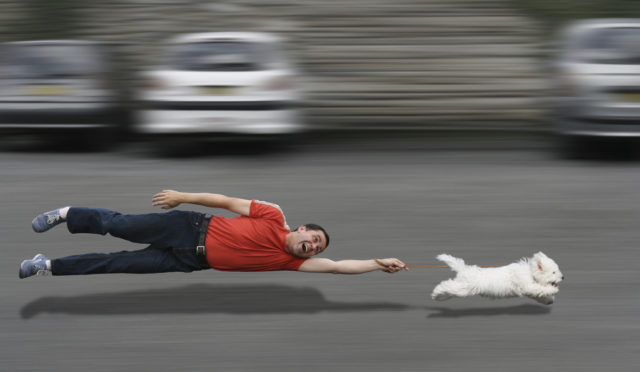By Koru K9 Dog Training + Rehabilitation
Do you look like the guy in the picture above when walking your dog? One of the most common complaints that we receive as dog trainers is, “my dog pulls on leash.” We’ve all seen those people, or maybe you are one of those people, their dog is essentially walking them. Completely out at the end of the leash, the owners arm extended like it’s in some Midevil torture device.
Typically we see one of two things happening: Fluffy is either pulling like he’s running the Iditarod, nails scraping, gasping for breath, with the owner trailing behind. Usually, calling to the person ahead, “He’s friendly!” Or, we see the owner pulling back on Fluffy, trying to pull him into place as Fluffy turns into a white-hot ball of terror at another dog. Guess what…NEITHER WORKS! Shocking, I know.
So, what’s going on here? Why on Earth do these dogs continue to pull to the point where they sound like they are being choked? It’s because of a little autonomic response in dogs called the Opposition Reflex. Autonomo-what? Opposition-who? In simple terms, it means that our dogs are hardwired with an involuntary response to physical pressure. The more you pull, the harder he’s going to pull back.
Want to see the Opposition Reflex at work? Watch sled dogs, pulling those sleds while harnessed up. Or take a look at Nero in his harness in our training videos. In both situations, that is the opposition reflex at work…in a positive way though. Turns out most people walking down the street, don’t want their dog to be a part of the next best sled team.
Let’s take a look at this scenario: little Fluffy is pulling, pulling, pulling and Fluffy’s owner is allowing him to continue moving forward. Score! Fluffy thinks this is the best thing ever…that pulling REALLY hard = me getting where I want to go, after all, his owner is allowing this to happen, it must be okay. Then, Fluffy is rewarded by going to the park, playing with dogs, being pet or given treats by the neighbor…whatever the case may be. SCORE again! Fluffy then equates pulling to not only getting to go where he wants, he also gets some pretty cool stuff when he’s there. Fluffy – 2, Owner – 0. That’s no beuno, my friends.
Now, if you are one of those people, you’re thinking, “great, so this is why my dog does this…what can I do about it.” Well, the easy answer, teach your dog to walk on leash properly and with manners. The difficult part of that answer is that no two dogs are alike and different techniques work with different dogs. Here are a few things you can start to work on:
Ditch your retractable leash. Get a good, old fashioned, 6-foot leash. Keep the leash short, but loose.
Is your collar or harness low on your dogs neck? That’s just helping your dog pull! Let’s look again at the sled dogs…that low neck/shoulder area is where all the dog’s pulling power is. Your collar should be placed high on the neck.
How you begin your walk sets the tone for your walk. Does Fluffy go ape every time you pick up the leash, spinning and jumping even before you left the house? And then you go on your walk? Guess what, you’ve rewarded that behavior…Fluffy now knows that acting ape is the key to getting to go outside. Set yourself up for success!
DON’T PULL BACK ON YOUR LEASH when you see another dog. Dogs feel your tension and read our energy and body language.
You can try the red light/green light method. Dog pulling = red light and no movement. Dog walking at your side in a relaxed heel position = green light. Movement is reward for you dog. I will tell you that this method takes a LOT of patience and persistence and being consistent.
Lastly, know that the longer you let this behavior continue, the worse it will get and can escalate into other dog reactive issues. Getting the help of a professional dog trainer is highly recommended to help nip any problem behaviors in the bud.
Most importantly, remember to reward your dog for good behaviors! All too often we see owners so focused on the bad behavior that they forget to reward the good. Praise, affection, food, treats, play…those are all rewards for your dog.

